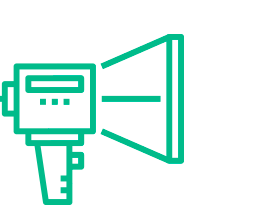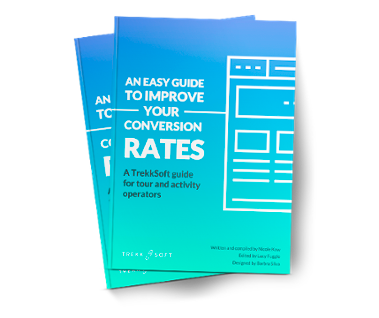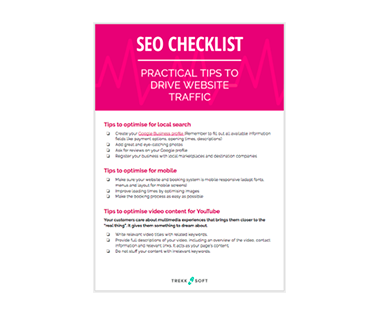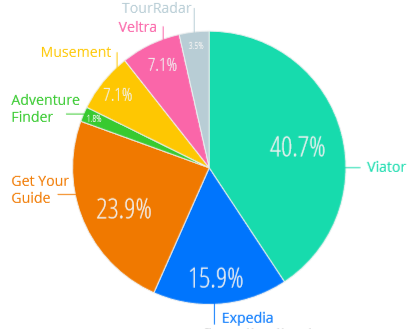When you're selling tours and activities, the most important way to compete in your destination is by offering the best product. But you can't ignore marketing. To be a successful tourism business, you need to reach your target audience via the right channels – be it Google searches, through partners, on review platforms like TripAdvisor, or word of mouth. Here's our marketing masterclass for tour and activity companies, compiling the best advice we have on the core pillars for businesses like yours.

To improve your marketing, start by thinking about the core parts of your customer decision journey, or the stages your customer passes through before and after becoming your customer.
In the marketing world, this often consists of Awareness – Consideration – Conversion – Loyalty – Advocacy.
However, we prefer Google's outline of the "micro-moments" that exist in travel:
We also add "sharing moments" on the end, for the crucial moment when your guests become brand ambassadors and generate word-of-mouth for you.
To better understand your customer journey and how to strengthen every stage, head over to A marketing guide for each stage of the travel customer journey.
Your website is the cornerstone of your marketing. It's your online shopfront, brand, and strongest tool to inspire guests to book your trip instead of your competitor's.
To improve conversions on your website:
Read more: 5 tips to build a tour or activity operator website that converts more customers
To get more booked customers from your website visitors, download our Booking Conversion Guide. It comes with a printable checklist that you can print out for reference.
Get your free e-book
To get your website found, you need to think about search engine optimization: SEO.
As TrekkSoft's Nicole Kow writes in her article SEO in 2018: How tour and activity operators can drive website traffic, Google’s algorithm is way smarter than we think. It's capable of understanding meanings instead of phrases, which is why overloading pages with keywords is no longer effective or relevant.
It means that we need to focus on the search experiences instead of figuring out how to beat algorithms. Key takeaways:
In short, be there and be useful.
Nicole also recommends that you download our SEO checklist and run through it every 2 weeks to keep your website search engine-optimised.
Get your checklist
Marketing your tours and activities is all about effective distribution.
Back in 2016, we ran our very first distribution survey. Of the 41.3% of business (out of 209 participants) who sell their tours on OTAs, Viator was the leading OTA of choice, followed by Expedia and Get Your Guide. Not much has changed since then.
Although marketplaces like Viator and Expedia were driving under 11% of all tour and activity sales according to separate TrekkSoft data in 2018, this is growing.
Phocuswright has predicted that the online reseller market share will double by 2020, as suppliers look to these platforms to expand into new markets and reach new customers.
In data from our 2018 Tourism Survey, we’re seeing the booking share rise for marketplaces. Here is the answer from over 750 tour operators on what marketplaces give them the best return:

Read more
Spotlight on Civitatis, the leading Spanish speaking marketplace
We compare two OTA giants: Viator vs Expedia Local Expert
Channel Manager 101: How to connect to online marketplaces to reach a larger market
With an all-in-one booking system like TrekkSoft, you can manage all of your bookings in one place: bringing your phone, email, and walk-in bookings together with your online reservations.
With a Point of Sale (POS) Desk, you can seamlessly process walk-in bookings and also give your agents a tool to boost their sales on any device.
The TrekkSoft POS Desk interface consists of three simple tabs – Activity, Calendar and Last Bookings – making it easy for you and your agents to find what you're looking for.
Think of the POS Desk as a professional terminal to showcase and sell your trips, whether at your store or via third parties such as hotel concierge desks or visitor centres. It's fully compatible with your iPad or Android tablet.
Build a stronger distribution strategy by diversifying the channels you use: 21 distribution channels every tour operator should consider using
How's your social media presence? Today, brand identity continues to be tightly tied to social media and user-generated content. To define your social media strategy as a tour or activity operator or destination, we advise looking to your consumer behaviour before anything else.
Which social media platforms are your customers using? Where do they talk about your business and your destination?
You need to ensure you're active on these platforms, both in terms of sharing new content and engaging with people who talk about your products. For most tour and activity companies, we see them focusing on:
Facebook.For many tour & activity companies, Facebook is a key part of your online presence. It's worth thinking about your Facebook profile as another shopfront for your business: it helps to define your brand, facilitates communication with booked guests and potential customers, and gives out credibility signals for whether you're a trustworthy business to book with. Post regularly, share content of your tours and destination (including user-generated content), and engage with your followers. Over time, build up Facebook reviews by providing an exceptional customer experience.
Instagram.This is one of the best marketing tools out there to define and consolidate brand identity as a travel experience provider. Operators and destinations with well-thought-out strategies, originality, and regular posts are the ones standing out.
Among tour and activity providers, we don't see as much focus on Twitter. However, if your customers are using the platform then it's worth being there too – especially if you receive tweets with questions or last-minute communication about your activities.
Saying that, if you can't stay on top of a social media platform and provide speedy answers: it's not worth being there. Having a social media profile is a signal that you are open to communication through it – you can't afford to miss messages.
For each social media page you have, you also need to be happy with the brand identity it gives off. Does your Facebook, Instagram, or Twitter page match how you want to be perceived as a travel provider? If not, identify the issues now and make a plan to improve them. There's always a chance your potential guests will check you out on social media before booking – or find you through it.
One final piece of advice for social media: it's important not to spread yourself too thin. If there's one platform that most of your guests use and which brings you most results, it's perfectly acceptable to focus more on that!
Messaging Apps. For a more direct way to speak to your customers, messaging apps are becoming the fastest and most convenient way to connect and enhance their travel experience. According to Business Insider, the average smartphone owner uses 27 apps on their phone per month and the top four messaging apps (Messenger, WhatsApp, WeChat and Viber) have more monthly active users than the top four social networking apps (Facebook, Twitter, Instagram and Google+ .
Read More
Communication through messaging apps
Do tour and activity operators need Facebook
Travel providers need to consciously manage their reputation online – guests can and will find everything! Saying that, you can't hide bad reviews: the only real strategy is to provide incredible customer experience, accepting you'll get the occasional bad review, and dealing with these quickly, professionally, and honestly.
For our Travel Trends Report 2018, we looked at the commonalities of the top tour & activity companies processing bookings with TrekkSoft.
No surprises here: the top twenty by revenue generally had excellent online reviews. These providers had:
A good TripAdvisor ranking is the industry’s worst kept secret – but it’s not a quick fix.
It takes unwavering dedication to quality and excellence across the entire business at every stage of the travel customer journey: before, during and after the activity. Without prioritising your customer experience, you're never going to reach the upper echelons of TripAdvisor glory – no matter how many quick fixes you try.
How to manage negative reviews
TripAdvisor checklist - 20 steps to improve your ranking and reach #1
How to conduct mid-season reviews
Half of your potential customers are likely to already be on site. So, how do you attract and convert the ever-connected and spontaneous travel segment in your destination?

A key part of the business model of SANDEMANs New Europe, the largest free walking tour provider, is their partnerships with accommodation providers in destination, especially hostels. Hostel guests can sign up for departures for the walking tour at the front desk – or just be in the lobby at the set time to be picked up by the guide. This is great news for guests, and perfect for unscheduled mornings where they want an easy way to see a city without hassle or advanced planning.
Read more
Could partnering with hotels increase your bookings?
To tell if your marketing is working as a tour & activity company, you need to be looking at:
An effective marketing strategy for tourism companies should focus on your customer and intentionally guide them throughout their customer journey. To see how effectively your efforts are working to move your customers along the journey, you can use specific metrics to measure your performance.
But don't get caught up in vanity metrics. It's fine to focus on just a few important KPIs, or key performance indicators, and leave it at that. You don't need to check how many Facebook followers you have every day.
Each metric you track should be focused on leading towards a paid customer who turns up and has a great time on your tour or activity.
Read more
The best way to measure growth of your business
6 key performance indicators (KPIs) for tour and activity providers

We understand the tour and activity industry and you can rely on our team to onboard your business, introduce you to digital best practice, and guide you to success.
2010-2025 TrekkSoft | A TrekkSoft Group company
2010-2024 TrekkSoft | A TrekkSoft Group company